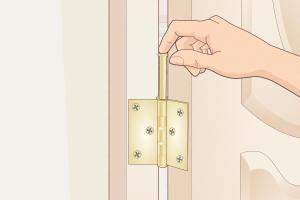Simple Solutions to Fix a Rubbing Door: A Comprehensive Guide

-
Quick Links:
- Introduction
- Understanding Rubbing Doors
- Common Causes of Rubbing Doors
- Tools and Materials Needed
- Step-by-Step Guide to Fix a Rubbing Door
- Additional Tips for Preventing Rubbing Doors
- Case Studies
- Expert Insights
- FAQs
Introduction
Have you ever experienced the annoyance of a rubbing door? It’s a common issue that can occur in any home, yet many homeowners overlook it. A rubbing door can lead to scratches, damage to the frame, and even create an uncomfortable atmosphere in your living space. In this comprehensive guide, we will explore the causes of rubbing doors and provide you with effective solutions to fix them.
Understanding Rubbing Doors
A rubbing door occurs when the door does not align properly with its frame or the doorstop. This misalignment can lead to friction between the door and the frame, causing annoying noises and potential damage over time. Understanding the mechanics of your door and its components is essential for effective repairs.
Common Causes of Rubbing Doors
- Humidity: Changes in humidity can cause wooden doors to swell, leading to rubbing.
- Improper Installation: A door that is not installed correctly may not align with the frame.
- Worn Hinges: Old or damaged hinges can affect the door's positioning.
- Foundation Shifts: Settling foundations can alter door alignment over time.
Tools and Materials Needed
Before you begin fixing your rubbing door, ensure you have the following tools and materials:
- Screwdriver
- Chisel
- Wooden shim
- Sandpaper
- Measuring tape
- Level
- Wooden block (if needed)
Step-by-Step Guide to Fix a Rubbing Door
Step 1: Identify the Problem Area
Open and close the door to find where it rubs against the frame. Inspect the door and frame closely to identify any visible gaps or overlaps.
Step 2: Check the Hinges
Examine the hinges for wear or damage. Tighten any loose screws and replace damaged hinges if necessary.
Step 3: Adjust the Hinges
To lower the door, remove the top hinge and add a shim behind it. If raising the door, shim the bottom hinge instead. Test the door after each adjustment.
Step 4: Trim the Door
If the door continues to rub, you may need to trim it. Use a chisel and sandpaper to carefully remove material from the edges where it rubs.
Step 5: Recheck Alignment
Once adjustments are made, use a level to ensure the door is properly aligned. Close the door several times to ensure it no longer rubs.
Additional Tips for Preventing Rubbing Doors
- Regularly check and maintain door hinges.
- Keep humidity levels stable to prevent wood swelling.
- Consider door stops to prevent over-swinging.
Case Studies
Case Study 1: The Swelling Door
In a home in Florida, a wooden door began to swell during the summer months. The homeowner noticed it was rubbing against the frame. After adjusting the hinges and checking humidity levels, the issue was resolved.
Case Study 2: The Settling Foundation
A homeowner in California faced a similar issue when their house settled after heavy rain. They found that shimming the hinges effectively aligned the door once again.
Expert Insights
According to carpenter John Doe, "Most rubbing door issues can be solved with simple adjustments. However, if the problem persists, it could indicate deeper structural issues." Consulting with a professional may be necessary in such situations.
FAQs
1. What causes a door to rub against its frame?
Common causes include humidity, improper installation, worn hinges, and foundation shifts.
2. Can I fix a rubbing door myself?
Yes, most rubbing door issues can be easily fixed with basic tools and adjustments.
3. How do I know if my door needs trimming?
If adjustments to the hinges don’t resolve the rubbing, trimming may be necessary.
4. What tools do I need to fix a rubbing door?
You will need a screwdriver, chisel, wooden shim, sandpaper, measuring tape, a level, and possibly a wooden block.
5. How can I prevent my door from rubbing in the future?
Maintain stable humidity levels, regularly check hinges, and consider door stops.
6. Can humidity affect my door?
Yes, high humidity can cause wooden doors to swell, leading to rubbing.
7. How often should I check my door hinges?
It's a good idea to check them every few months or whenever you notice any issues.
8. What if my door is still rubbing after adjustments?
If the problem persists, it may be necessary to consult a professional for a deeper inspection.
9. Is it better to trim the door or adjust the hinges?
Start with hinge adjustments; if that doesn’t work, consider trimming the door.
10. What should I do if my door frame is damaged?
If the frame is damaged, it may require repairs or replacement before resolving door issues.